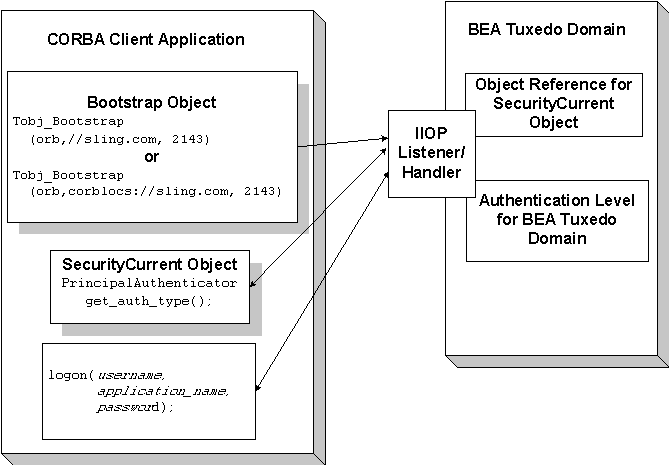
![BEA BEA Tuxedo Release [Release Number]](../images/top.gif)

|
![BEA BEA Tuxedo Release [Release Number]](../images/top.gif)
|
|
|
|
Using Security
This topic includes the following sections:
Note: This chapter describes how to use authentication. For a complete description of all the security features available in the CORBA security environment and instructions for implementing the features, see Using Security in CORBA Applications in the BEA Tuxedo online documentation.
Overview of the Security Service
The CORBA environment in the BEA Tuxedo product offers a security model based on the CORBA Services Security Service. The BEA Tuxedo CORBA security model implements the authentication portion of the CORBA Services Security Service.
In the CORBA environment security information is defined on a domain basis. The security level for the domain is defined in the configuration file. Client applications use the SecurityCurrent object to provide the necessary authentication information to log on to the BEA Tuxedo domain.
The following levels of authentication are provided:
No authentication is needed; however, the client application may still authenticate itself, and may specify a username and a client application name, but no password.
The client application must authenticate itself to the BEA Tuxedo domain and must specify a username, client application name, and application password.
In addition to the TOBJ_SYSAUTH information, the client application must provide application-specific information. If the default BEA Tuxedo CORBA authentication service is used in the application configuration, the client application must provide a user password; otherwise, the client application provides authentication data that is interpreted by the custom authentication service in the application.
Note: If a client application is not authenticated and the security level is TOBJ_NOAUTH, the IIOP Listener/Handler of the BEA Tuxedo domain registers the client application with the username and client application name sent to the IIOP Listener/Handler.
In the BEA Tuxedo CORBA security environment, only the PrincipalAuthenticator and Credentials properties on the SecurityCurrent object are supported. For a description of the SecurityLevel1::Current and SecurityLevel2::Current interfaces, see the CORBA Programming Reference in the BEA Tuxedo online documentation.
How Security Works
Figure 4-1 illustrates how CORBA security works in a BEA Tuxedo domain.
Figure 4-1 How CORBA Security Works in a BEA Tuxedo Domain
Note: BEA Tuxedo CORBA also supports the use of the CORBA Interoperable Naming Service (INS) to obtain an initial object reference for the Security Service. For information on the INS bootstrapping mechanism, see the CORBA Programming Reference.
The Security Sample Application
The Security sample application demonstrates how to use password authentication. The Security sample application requires that each student using the application has an ID and a password. The Security sample application works in the following manner:
Note: Certificate authentication is illustrated in the Secure Simpapp sample application.
Figure 4-2 illustrates the Security sample application.
Figure 4-2 Security Sample Application
The source files for the Security sample application are located in the \samples\corba\university directory in the BEA Tuxedo software. For information about building and running the Security sample application, see Using Security in CORBA Applications in the BEA Tuxedo online documentation.

Development Steps
Table 4-1 lists the development steps for writing a BEA Tuxedo CORBA application that employs authentication security.
Table 4-1 Development Steps for BEA Tuxedo CORBA Applications That Have Security
|
Step |
Description |
|---|---|
|
1 |
Define the security level in the configuration file. |
|
2 |
Write the CORBA client application. |
Step 1: Define the Security Level in the Configuration File
The security level for a BEA Tuxedo domain is defined by setting the SECURITY parameter in the RESOURCES section of the configuration file to the desired security level. Table 4-2 lists the options for the SECURITY parameter.
Table 4-2 Options for the SECURITY Parameter
In the Security sample application, the SECURITY parameter is set to APP_PW for application-level security. For information about adding security to a BEA Tuxedo CORBA application, see Using Security in CORBA Applications in the BEA Tuxedo online documentation.
Step 2: Write the CORBA Client Application
Write client application code that does the following:
Listing 4-1 and Listing 4-2 include the portions of the CORBA C++ and CORBA Java client applications in the Security sample application that illustrate the development steps for security.
Listing 4-1 Example of Security in a CORBA C++ Client Application
CORBA::Object_var var_security_current_oref =
bootstrap.resolve_initial_references("SecurityCurrent");
SecurityLevel2::Current_var var_security_current_ref =
SecurityLevel2::Current::_narrow(var_security_current_oref.in());
//Get the PrincipalAuthenticator
SecurityLevel2::PrincipalAuthenticator_var var_principal_authenticator_oref =
var_security_current_ref->principal_authenticator();
//Narrow the PrincipalAuthenticator
Tobj::PrincipalAuthenticator_var var_bea_principal_authenticator =
Tobj::PrincipalAuthenticator::_narrow (
var_principal_authenticator_oref.in());
//Determine the security level
Tobj::AuthType auth_type = var_bea_principal_authenticator->get_auth_type();
Security::AuthenticationStatus status = var_bea_principalauthenticator->logon(
user_name,
client_name,
system_password,
user_password,
0);
Listing 4-2 Example of Security in a CORBA Java Client Application
org.omg.CORBA.Object SecurityCurrentObj =
gBootstrapObjRef.resolve_initial_references("SecurityCurrent");
org.omg.SecurityLevel2.Current secCur =
org.omg.SecurityLevel2.CurrentHelper.narrow(SecurityCurrentObj);
//Get the PrincipalAuthenticator
org.omg.SecurityLevel2.PrincipalAuthenticator authlevel2 =
secCur.principal_authenticator();
//Narrow the PrincipalAuthenticator
com.beasys.Tobj.PrincipalAuthenticatorObjRef gPrinAuthObjRef =
(com.beasys.Tobj.PrincipalAuthenticator)
org.omg.SecurityLevel2.PrincipalAuthenticatorHelper.narrow(authlevel2);
//Determine the security level
com.beasys.Tobj.Authtype authType = gPrinAuthObjRef.get_auth_type();
org.omg.Security.AuthenticationStatus status = gPrinAuthObjRef.logon
(gUserName, ClientName, gSystemPassword, gUserPassword,0);

|

|

|
|
|
|
Copyright © 2001 BEA Systems, Inc. All rights reserved.
|